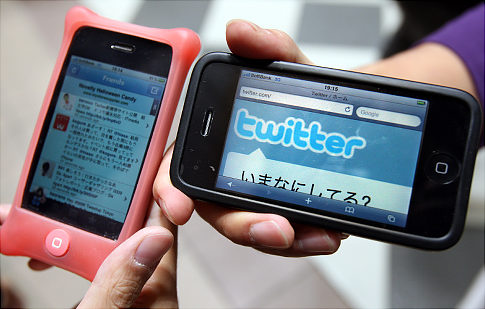Twitter as eWoM-cashcow?
Sander Jansma already discussed the phenomenon of ‘word-of-mouth’, the so-called WoM. The idea of passing information from person to person has been around since humankind could communicate orally and has evolved with the rise of different means of communication. WoM is no longer all about speaking but also found his way in face-to-face, texting, telephone, email and nowadays ofcourse the Internet, a platform where it seems to have reached its boiling point.

With the current Internet being all about social communication platforms and the idea of words and ideas spreading through conservations between members of those platforms it has become really significant and a big impact on a lot of our practices online. One of the practices it has an impact on is the key element in the costumer-company relationship: brand image and brand awareness. While the power and influence of WoM on costumer buying decisions has already been recognised by marketeers as a powerful tool to influence consumers, a new kind of WoM-marketing seems to emerge: electronic WoM (eWoM). ‘Brand management is transforming as communication technology changes’ (Jansen & Zhang, 2009: p. 2170) we are leaving the uncontrollable WoM campaigns and enter the era of eWoM:
that they are willing to share with others in short posts (i.e., microblogs). These posts are then distributed by instant messages, mobile phones, email, or the Web’ (Jansen & Zhang, 2009: p. 2170). The conversational power of Twitter has also been recognised by Honeycutt & Herring who ‘predict that tools such as Twitter will soon come to be used in formal collaborative contexts, as well for example, in work involving distributed teams, much like instant messaging before them’ (Honeycutt & Hering, 2009: p. 9). But what makes microblogging websites so much stronger as eWoM marketing tool than full blogs, webpages and online reviews? Micro-branding comments are immediate, ubiquitous, and scalable and offer companies an immediate insight in reactions toward products and the decisions costumers make:

It is the same implication that Wired adresses when talking about making money on Twitter through advertisement: ‘The most obvious solution to how Twitter can make money would be to serve advertising directly in a user's Twitter feed (or "timeline" as the company calls it), or elsewhere on the site. But Stone and his fellow execs are wary of alienating Twitter's hardcore user base, which has grown accustomed to an ad-free service.’ Surely the difference between these advertisement and eWoM-marketing is that user choose to follow a certain corporate account and want to get messages instead of the mostly unwanted advertising. But like I said before there is nothing wrong with a company trying to get closer to its costumers and offering a helpful service but for users on a social networking site there exists a delicate balance between seeing something as a helpful service and the feeling that companies are just trying to make money out of them. There is the danger of companies seeing Twitter too much as a cashcow and therefore paradoxically ruin their chances of using it as a eWoM marketing form: do they suffer the same fate as spam on Twitter? So it seems that companies carefully must choose how and whether to expand their eWoM marketing strategies beyond service and monitoring because Twitter as social networking site implies that users are still in control. Further research should be done on the pitfalls and dangers that companies could encounter when expanding their marketing practices on Twitter.

With the current Internet being all about social communication platforms and the idea of words and ideas spreading through conservations between members of those platforms it has become really significant and a big impact on a lot of our practices online. One of the practices it has an impact on is the key element in the costumer-company relationship: brand image and brand awareness. While the power and influence of WoM on costumer buying decisions has already been recognised by marketeers as a powerful tool to influence consumers, a new kind of WoM-marketing seems to emerge: electronic WoM (eWoM). ‘Brand management is transforming as communication technology changes’ (Jansen & Zhang, 2009: p. 2170) we are leaving the uncontrollable WoM campaigns and enter the era of eWoM:
‘eWOM offers a variety of means to exchange information, many times anonymously or coindentially, as well as to provide geographical and temporal freedom; moreover, eWOM has at least some degree of permanence’Twitter as microblogging website has been put forward as a new form of this eWoM marketing, the latest tool in our attention economy: ‘microblogging is a new form of communication in which users can describe things of interest and express attitudes
that they are willing to share with others in short posts (i.e., microblogs). These posts are then distributed by instant messages, mobile phones, email, or the Web’ (Jansen & Zhang, 2009: p. 2170). The conversational power of Twitter has also been recognised by Honeycutt & Herring who ‘predict that tools such as Twitter will soon come to be used in formal collaborative contexts, as well for example, in work involving distributed teams, much like instant messaging before them’ (Honeycutt & Hering, 2009: p. 9). But what makes microblogging websites so much stronger as eWoM marketing tool than full blogs, webpages and online reviews? Micro-branding comments are immediate, ubiquitous, and scalable and offer companies an immediate insight in reactions toward products and the decisions costumers make:
‘The essence of eWOM communicating and customer relationship management is knowing what customers and potential customers are saying about the brand. Microblogging provides a venue into what customers really feel about the brand and its competitors in near real time. Additionally, microblogging sites provide a platform to connect directly, again in near real time, with customers, which can build and enhance customer relationships.’Most of the research that has been done on eWoM primarily focused on webpages, blogs and online reviews and until recently did not include microblogging websites. Jansen & Zhang try to answer some questions surrounding these sites like ‘What types of branding sentiment do these microblogs express?’ and ‘What are their effects on online reputation management? And deliver us insights like ‘the ratio of positive to negative branding tweets is about 50% to 35%, with the remaining being neutral’ and ‘general patterns in how companies are leveraging microblogging for eWOM branding’. And I can not deny that Twitter can be considered as some kind of cultural and business thermometer: just take a look at the trending topics on Twitter and you know what people are talking about or search for a product and see what people are saying about it. Twitter is also undeniably a platform where companies can create the feeling of presence: an answer to your question or announcement is just a tweet away as Dutch companies UPC and HEMA show us. But the fact that we are still dealing with a social networking site for me creates some implications.

It is the same implication that Wired adresses when talking about making money on Twitter through advertisement: ‘The most obvious solution to how Twitter can make money would be to serve advertising directly in a user's Twitter feed (or "timeline" as the company calls it), or elsewhere on the site. But Stone and his fellow execs are wary of alienating Twitter's hardcore user base, which has grown accustomed to an ad-free service.’ Surely the difference between these advertisement and eWoM-marketing is that user choose to follow a certain corporate account and want to get messages instead of the mostly unwanted advertising. But like I said before there is nothing wrong with a company trying to get closer to its costumers and offering a helpful service but for users on a social networking site there exists a delicate balance between seeing something as a helpful service and the feeling that companies are just trying to make money out of them. There is the danger of companies seeing Twitter too much as a cashcow and therefore paradoxically ruin their chances of using it as a eWoM marketing form: do they suffer the same fate as spam on Twitter? So it seems that companies carefully must choose how and whether to expand their eWoM marketing strategies beyond service and monitoring because Twitter as social networking site implies that users are still in control. Further research should be done on the pitfalls and dangers that companies could encounter when expanding their marketing practices on Twitter.

1 reacties:
A professionally crafted logo jpeg is one of the greatest blessings for a company; whether it is big or small. It gives them an identity of their own and makes them different from others.
Een reactie posten
Aanmelden bij Reacties posten [Atom]
<< Homepage